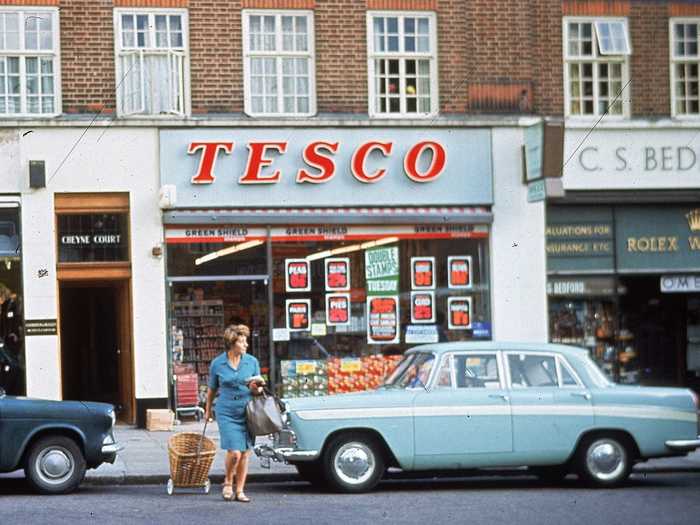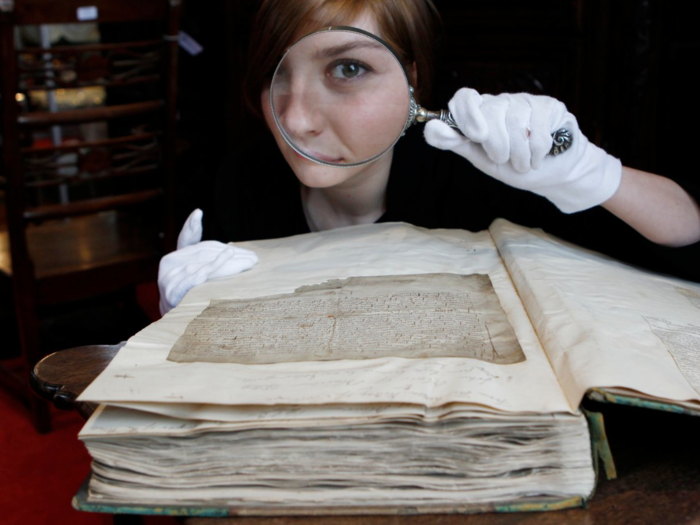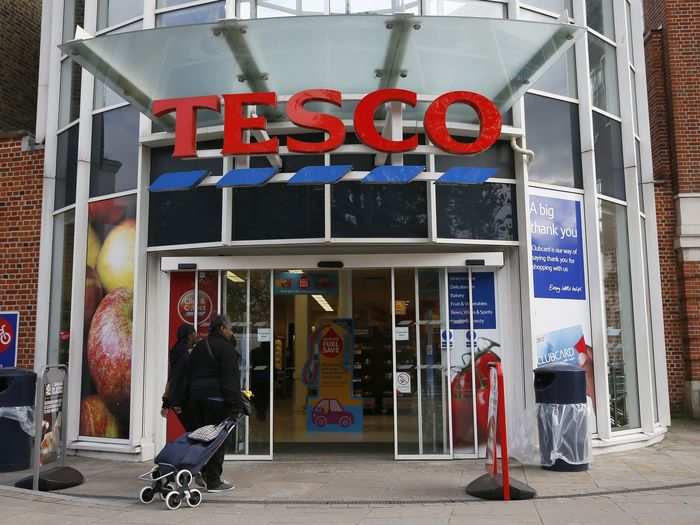The incredible rise and fall of Tesco
Tesco started as a market stall in East London in 1919.

In 1934, Cohen opened a food warehouse in North London to serve his consumer stores.

A few years later he began expanding to the London suburbs.
The Tesco brand name came from the first three letters of Cohen's tea supplier, T. E. Stockwell, combined with the first two letters of his own last name.
Tesco listed on the London Stock Exchange in 1947.

It took years for Cohen's warehouse chain to become an actual set of consumer groceries. Tesco was floated on the stock exchange with a share price of 25 pence.
A decade later, Cohen launched Tesco's first large, self-service supermarket in Essex.

The store's ticketed car park — with an automatic ticket barrier! — was modern and novel enough to warrant a film being made about it.
In the late 1950s and early 1960s, the company purchased more than 500 new stores.

Jack Cohen’s business motto was “pile it high and sell it cheap."
Cohen would give favoured executives this tiepin, with a mysterious motto, "YCDBSOYA."

It stood for, "You can't do business sitting on your arse."
Cohen died in 1979.

But his company's market share eventually surpassed Sainsbury's, becoming nearly twice as big as it nearest rival.

By the early 2000s, Tesco was on track for global domination.

Tesco opened hundreds of stores in China. But its largest presence outside the UK is Homeplus, its Korean arm, with over 400 stores. It also operates in India, Malaysia, and across the EU, often under different banners.
The expansion in the early 2000s put it next to France's Carrefour for the title of the world's second biggest retailer (Walmart is first).
But sales did not keep pace with the store's ambitious expansion plans.

In real terms, Tesco’s sales per square foot are currently at their lowest levels since 2005. After accounting for inflation, it's even worse.
The 2008 financial recession triggered a global retreat.

Tesco had accumulated a huge amount of floor space and land, with the anticipation of expansion that never truly filled it.
While other companies began cutting prices to cater for newly poor shoppers, Tesco was slower to respond.
Even China didn't work out.

Tesco began talking to China Resources Enterprise, a massive domestic retailer, about a potential partnership. In May 2014, it was announced that the Tesco's Chinese arm would merge with CRE, but that Tesco would only take a 20% stake in the firm.
The partnership still isn't profitable, according to Reuters.
Things started to turn south in 2013 when Tesco reported its first drop in profits in 20 years. That same year, the company decided to exit the US market.

In September 2013, Tesco agreed to sell more than 150 Fresh & Easy stores that it had set up just seven years earlier in the south and west of the US.
The grocery chain called the move "an orderly and efficient exit from the US market."
In 2014, Tesco announced that £250 million in profits had simply disappeared.

Accountancy giant Deloitte was brought in to investigate. The retailer had warned months earlier that the way it registered commercial income was "at risk of manipulation" by auditors.
It also became apparent in the days after the announcement that Laurie McIlwee, Tesco's finance director, was not actually at work. McIlwee had already handed in his notice and had been effectively absent during the search for a replacement.
The fallout was ugly for management.

Tesco suspended four executives in the immediate aftermath of the profit fiasco, and a further three this October.
On Thursday, after Deloitte confirmed the income statement error and increased the overestimate to £263 million, it announced that chairman Sir Richard Broadbent was stepping down.
New CEO Dave Lewis had no idea about the time bomb he inherited.

Former Unilever executive Dave Lewis only joined Tesco as its new CEO a few months before the massive profit error was announced. He told investors he had no idea Tesco was so screwed up.
Lewis took over from former CEO Philip Clarke, who resigned.
Since the September announcement, Tesco has continued to shock the market.

Tesco’s share price peaked at nearly £4.87 in 2007, dropping to £2.95 in late 2008 after the financial crisis.
Tesco’s share price rose back to above £4 for a lot of 2010 and 2011, when the economy was still weak. It is down to less than half of that now.
The firm has issued four profit warnings in the last three years.
Tesco is still the UK retail market leader, but that position is under threat.

Tesco is still the country's biggest supermarket, Europe's largest private employer, and the world's second-largest retailer — second only to Walmart.
But holding that position is proving difficult.
The supermarket’s market share is firmly below 30%, falling to 28.4% of Britain's market share at Kantar Worldpanel’s last count. This is down from the 30.1% slice of the market is had in 2012.
Is there a chance to save Tesco?

Things might look bad now, but banking giant HSBC thinks Tesco is poised for a turnaround.
The supermarket has improved notably under new CEO Dave Lewis, who took the reigns just as the full extent of the company's financial weakness became clear.
Lewis and new CFO Andy Stewart have been at the head of attempts to reform the company.
Despite a period of massive underperformance, Tesco has been catching up with the industry in terms of sales growth. It's now no longer losing significant market share, according to HSBC analysts.

Discount chains Aldi and Lidl are still gaining, but the effect of competition is becoming slightly more muted compared to a year ago. Sales growth at both firms seems to be slowing, as is market share growth.

HSBC maintains that, in the long-term, Tesco is better-placed to perform than the other major supermarkets due to its sheer size.

Tesco benefits from buying power, fixed costs (costs for things like advertising are more expensive for smaller companies if they want to match Tesco), and lower distributing costs due to the number of stores and employees.
The incredible rise and fall of Tesco

Popular Right Now
Popular Keywords
Advertisement